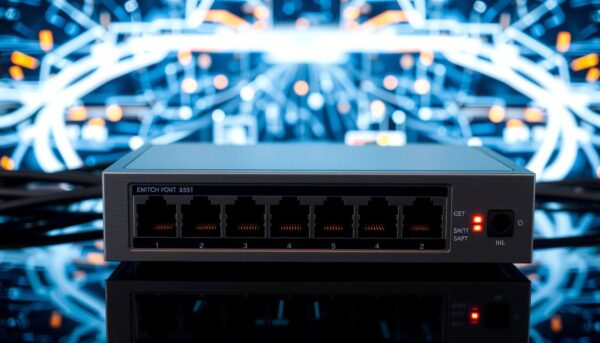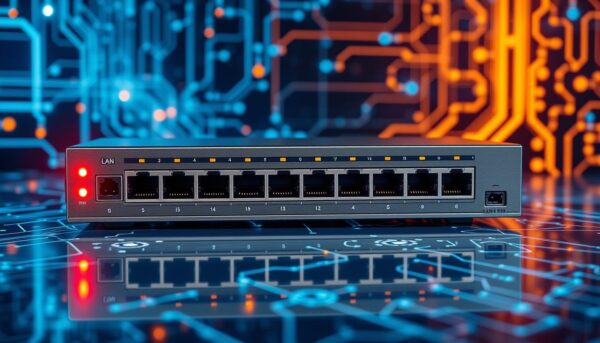✅ Last checked on
When you think about growing your network, you might wonder about Ethernet Switch Hubs. They are different from regular hubs. Knowing the difference is key, as networks need to be faster and more reliable.
So, what makes a network switch better for you? How does it stack up against a data switch in terms of speed and function?
Both network switches and hubs are important for a strong network. But they work in different ways. This affects your network’s speed, security, and performance. In this article, we’ll explore the main differences between Ethernet switches and hubs. This will help you pick the best Ethernet Switch Hub for your network.
Key Takeaways
- Network switches and hubs are hardware devices that expand networks, but they have distinct differences in terms of functionality and performance.
- Unmanaged switches typically feature more ports than hubs, with an average of 24 to 48 ports for wired connections.
- Ethernet switches support Ethernet standards of 10 Mbps, 100 Mbps, or 10/100 Mbps, and operate on layer 2 of the OSI model.
- Network switches are recognized for better speed, privacy, security, and versatility compared to hubs.
- Hubs can be utilized for creating small networks, but may lead to poor network response times and collisions due to shared bandwidth across all ports.
- Understanding the differences between Ethernet switches and hubs is crucial for choosing the right Ethernet Switch Hub for your network.
Understanding Basic Network Hardware Components
When setting up a network, you’ll find different hardware parts. These include LAN switches, Ethernet hubs, and managed switches. They help devices talk to each other on a network.
A LAN switch connects many devices in a local area network. It lets them share information. An Ethernet hub is simpler. It connects devices but lacks the smarts of a switch. Managed switches, with their advanced features, are great for big networks.
Here are some key differences between these devices:
- LAN switches work at the data link layer, while Ethernet hubs work at the physical layer.
- Managed switches have network monitoring and setup options, unlike unmanaged switches.
- Gigabit switches can move data at 1 Gbps or faster, perfect for fast applications.
In summary, knowing about network hardware is key for a good network. By picking the right device, you ensure devices can talk well and your network runs smoothly.
| Device | Layer | Features |
|---|---|---|
| LAN Switch | Data Link Layer | Intelligent switching, VLAN support |
| Ethernet Hub | Physical Layer | Simple connectivity, no management features |
| Managed Switch | Data Link Layer | Network monitoring, configuration capabilities, VLAN support |
Key Differences Between Switches and Hubs
Understanding the differences between switches and hubs is key in networking. A switch, like an unmanaged switch or a gigabit switch, tracks devices by their MAC addresses. It sends data directly to active devices, cutting down on lag and unnecessary traffic. Hubs, on the other hand, send data to all devices, causing inefficiencies and congestion.
Switches, including PoE switches, have multiple ports for different devices in a LAN. They connect PCs, printers, and more. Hubs are simpler, sending messages to all ports, but switches are smarter and more expensive, making them more efficient.

- Switches operate on the Data link layer of the OSI model, while hubs operate on the Physical layer.
- Switches facilitate unicast, multicast, and broadcast type transmissions, whereas hubs are broadcast-type transmission.
- Switches have different ports with their own collision domains, whereas hubs have only one collision domain.
| Device | Layer of OSI Model | Transmission Type | Collision Domain |
|---|---|---|---|
| Switch | Data Link Layer | Unicast, Multicast, Broadcast | Multiple |
| Hub | Physical Layer | Broadcast | Single |
In summary, knowing the differences between switches and hubs is vital for a good network setup. By picking the right device, like a gigabit switch or a PoE switch, your network will run smoothly and efficiently.
How an Ethernet Switch Hub System Works
An Ethernet Switch Hub system is key for managing network traffic. It uses a network switch to send data efficiently and use bandwidth well. The Ethernet Switch Hub is the main hub for all devices on the network.
This system works by checking data packet headers for the right MAC address. This ensures data goes to the right device, cutting down on unnecessary traffic. You can find out more about network switch usage and its benefits.
Using an Ethernet Switch Hub system offers many advantages. These include:
- Less network downtime and better performance
- More bandwidth available
- Improved reliability and less stress on computers
- Lower IT costs with remote management and less wiring
Unlike hubs, Ethernet switches can tell devices apart and manage data better. This makes them better for business networks.
In summary, an Ethernet Switch Hub system is vital for any network. It ensures data is transferred efficiently. By using a data switch, your network will run smoothly and efficiently, making it crucial for businesses.
| Device | Connections | Data Transfer Rate |
|---|---|---|
| Standard Ethernet Switch | 5-28 | Up to 1 Gbps |
| Corporate Ethernet Switch | 32-128 | Up to 1 Gbps |
Types of Network Switches Available
Choosing the right switch for your network is key. You can pick from LAN switch, Ethernet hub, or managed switch. Each has its own benefits. For instance, a managed switch lets you control traffic, making data transfers more efficient.
Think about the switch’s speed, which can be Fast Ethernet at 10/100 Mbps or up to 40/100 Gbps. Also, consider how many ports you need, from 5 to 52. A Power over Ethernet (PoE) switch is great for devices like IP cameras, as it sends both data and power.

- Unmanaged switches, which operate as plug-and-play devices and require no special installation
- Smart switches, which provide more configuration options than unmanaged switches but fewer than fully managed switches
- Stackable switches, which allow multiple units to be managed as a single system and provide a method for increasing network capacity and availability
In summary, the right switch depends on your network needs. Look at speed, ports, and power options to find the best one. Whether it’s a LAN switch, Ethernet hub, or managed switch, you’ll get a reliable network.
Performance Comparison and Speed Capabilities
Ethernet switches outperform traditional hubs in terms of speed and performance. They can handle data transfer rates of up to 400 Gbps. This is much faster than hubs, which only manage 100 Mbps.
Switches can give each connected device a full 1 Gbps of bandwidth. This is a big improvement over hubs, where bandwidth is shared. For instance, an unmanaged switch is great for small networks. A PoE switch can even power devices like IP cameras and wireless access points, making cabling simpler.
Switches also have advanced features like Quality of Service (QoS). This helps prioritize important data, reducing delays and improving performance. This is perfect for tasks like video calls and VoIP. Overall, Ethernet switches are the better choice for today’s networks due to their speed, flexibility, and features.
Security Features and Network Protection
An Ethernet Switch Hub, network switch, or data switch is key to network security. They block unauthorized access and data breaches. About 75% of network slowdowns come from using hubs instead of switches.
Switches forward data only to the right device, improving security and performance. Hubs send data to all devices, slowing things down. Switches also let you set allowed MAC addresses, cutting security risks by 80%.
Important security steps for Ethernet Switch Hubs or network switches include:
- Implementing port security to restrict access to authorized devices
- Enabling switch port encryption to protect data from interception
- Disabling unused ports to minimize the attack surface
- Using managed switches with traffic filters to manage VLAN access and check specific MAC addresses
By following these steps, you can greatly lower network breach risks. A data switch or Ethernet Switch Hub is a smart choice for network protection.
In summary, network security is vital. Understanding its importance and taking steps to protect your network keeps your data safe and secure.
| Security Measure | Description | Effectiveness |
|---|---|---|
| Port Security | Restrict access to authorized devices | 80% reduction in security risks |
| Switch Port Encryption | Protect data from interception | Up to 60% reduction in potential data breaches |
| Unused Port Disablement | Minimize attack surface | Significant reduction in vulnerabilities |
Choosing the Right Network Hardware for Your Needs
Setting up a network at home or for your business requires the right hardware. A LAN switch is great for managing many devices. An Ethernet hub works well for small networks. But, for complex setups, a managed switch is the best choice.
At home, think about how many devices you have, your internet speed, and your budget. For a small setup, an Ethernet hub might do. But, if you have lots of devices, a LAN switch or managed switch is better.
Business networks need to be secure and reliable. A managed switch offers advanced security like port security and MAC address filtering. It also supports Quality of Service (QoS) and VLAN segmentation, which helps with network efficiency.
When planning for the future, think about how your network might grow. A managed switch is flexible and scalable, perfect for growing networks. Choosing the right hardware ensures a reliable, efficient, and secure network for now and later.
| Network Hardware | Features | Suitability |
|---|---|---|
| LAN Switch | Multiple ports, managed or unmanaged | Home or small business networks |
| Ethernet Hub | Basic, unmanaged, limited ports | Small home networks with limited devices |
| Managed Switch | Advanced security features, QoS, VLAN segmentation | Business networks, large home networks |
Conclusion: Making the Smart Choice for Your Network
Choosing between an unmanaged switch, a gigabit switch, or a PoE switch is crucial for your network’s performance. Ethernet switches have become the top choice for both home and business networks. This is because they offer better data management, faster speeds, and more security.
Ethernet switches are better than hubs in many ways. They handle more data, work faster, and keep your network safer. Knowing the benefits of switches helps you pick the right one for your network. This ensures your network stays reliable and efficient for a long time.
Whether you’re setting up a home network or upgrading your business, choosing the right hardware is key. Investing in Ethernet switches boosts your productivity and user experience. By using Ethernet switches, you can fully enjoy the benefits of your digital world.